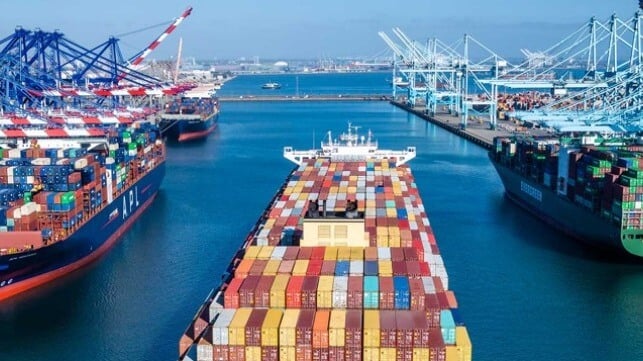At the TOC Europe Container Supply Chain 2025 event in Rotterdam, delegates were informed that China has been actively diversifying its export markets well before President Trump announced reciprocal tariffs. Nigel Pusey, CEO of Container Trade Statistics (CTS), highlighted that shifts in trade had been taking place for over two years, with Trump’s tariffs merely accelerating the process. This diversification strategy has become increasingly evident as China seeks to mitigate the impact of trade tensions and weakening global demand.

China’s efforts to diversify its export portfolio have been successful in reducing its dependence on developed markets. Since the onset of the US-China trade war in 2018, China has been expanding its exports to new markets such as countries along the Belt and Road Initiative (BRI), Africa, and Latin America. In 2023 Q1, China’s exports to the US fell by 17% year-on-year, while exports to BRI countries increased by 10%. Similarly, exports to South Asia and Latin America grew by 3.8% and 0.5% respectively.
This diversification has contributed to a more balanced global trade landscape. According to CTS data, global container volumes in March 2025 reached 16.2 million TEU, a 22.1% increase from February and a 6.5% increase from the same period last year. The first three months of 2025 saw volumes rise by 4.2% compared to 2024, reaching 44.8 million TEU.
However, the growth in container demand has been uneven, with regional and headhaul trades, particularly the transpacific and Asia-Europe routes, experiencing significant increases. Backhaul traffic, on the other hand, has witnessed a reversal in fortunes, dropping for the third consecutive month. Trade imbalances are growing or remaining steady on major trades, raising concerns about the reliance on and cost of empty equipment repositioning. This repositioning process takes time and has long lead times, increasing the risk of localized and temporary equipment shortages.
SeaIntelligence noted that the imbalance on the transpacific route has caught the attention of analysts. Volume on the eastbound headhaul trade continued to grow in March, climbing by 8.9% compared to 2024 levels. This growth was also seen across the first quarter, with cargo numbers increasing from 5.3 million TEU to 5.8 million TEU. In contrast, backhaul volumes in the first quarter were down by as much as 10.2%.
The global maritime industry is projected to experience robust trade growth in 2025, with container volumes expected to rise by 5% to 7%. This growth is driven by shifting trade routes and strong emerging markets. Companies are moving away from China, increasing demand for mid-sized, flexible vessels. In 2025, 83 mid-sized vessels (12,000–16,999 TEUs) are scheduled for delivery globally. Meanwhile, orders for mega-ships (17,000+ TEUs) have slowed, with just six slated for delivery this year.
Emerging economies in regions like Southeast Asia, Africa, and South America are fueling the demand for shipping services. These regions are not only increasing their export capacity but also becoming key importers of goods, creating new trade opportunities. Improved infrastructure, coupled with rising consumer demand in these markets, is enhancing global trade flows.
China’s export product mix is also evolving, with a focus on greener, more digitalized, and higher-end offerings. This shift strengthens the country’s competitiveness and adaptability in the face of changing trade dynamics. In 2024, China’s annual production of new energy vehicles exceeded 10 million units for the first time, with exports crossing the 2 million mark. This helps China carve out a position in the global marketplace and remain resilient amid growing protectionism and intensifying geopolitical tensions.
In summary, the emergence of secondary box trades and the diversification of global trade routes are reshaping the container shipping industry. While trade imbalances and equipment repositioning challenges persist, the overall outlook for global container volumes remains positive, driven by emerging markets and strategic investments in port infrastructure and shipping technologies.
